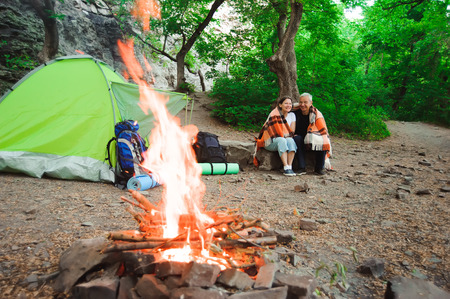1. Understanding Permits and Why They Matter
Backpacking across the U.S. is a dream for many, but before you set out on the trail, it’s important to know about permits, regulations, and legal requirements. These rules aren’t just paperwork—they’re essential for protecting both people and nature.
What Are Wilderness Permits?
A wilderness permit is an official document that allows you to enter certain protected areas. National Parks, National Forests, and some state lands require these permits for overnight stays or even day hikes in sensitive zones. The goal is to limit the number of visitors and reduce human impact.
Why Permits Matter
- Environmental Protection: Permits help prevent overcrowding and overuse, which protects wildlife and fragile ecosystems.
- Safety: Rangers know who’s out on the trail, which can help in emergencies.
- Fair Access: Everyone gets a chance to enjoy popular spots without them getting too busy.
Campsite Reservations: Do You Need One?
Some backpacking routes require you to reserve campsites in advance, especially in high-traffic areas like Yosemite or Grand Canyon. This keeps camping impact low and ensures everyone has a place to stay.
| Permit Type | Where Needed | How to Get It |
|---|---|---|
| Wilderness Permit | National Parks, Forests, Monuments | Online or visitor center (often lottery or first-come, first-served) |
| Campsite Reservation | Designated campgrounds, backcountry sites | Parks websites or reservation platforms like Recreation.gov |
| Special Use Permit | Group trips, research, commercial use | Parks office application process |
Common Questions from Backpackers
- Do I always need a permit? Not everywhere—some national forests and BLM lands are more flexible. Always check local rules before you go.
- What happens if I don’t have one? Fines are common, but you could also be turned away or asked to leave the area.
- Can I get walk-up permits? Some parks set aside last-minute permits for early arrivals at ranger stations.
The Takeaway: Respect the Rules, Protect the Land
Permits and reservations aren’t just red tape. They’re a way for all of us—backpackers and caretakers—to work together in keeping wild places wild for generations to come.
2. Federal and State Regulations
Backpacking in the U.S. means following a mix of federal and state rules. These laws help protect nature, wildlife, and ensure everyone’s safety. Knowing the difference between federal and state regulations is key before you hit the trail.
Federal Lands: National Parks, Forests, and More
Federal lands are managed by different agencies. Each has its own set of rules for backpackers:
| Type of Land | Agency | Main Rules for Backpackers |
|---|---|---|
| National Parks | National Park Service (NPS) | Permits often required for overnight stays; strict campfire restrictions; stay on marked trails; group size limits. |
| National Forests | U.S. Forest Service (USFS) | Permits sometimes required; dispersed camping allowed in many areas; check for fire bans and trail closures. |
| Bureau of Land Management (BLM) Lands | Bureau of Land Management (BLM) | More flexible camping rules; permits may be needed for certain areas; Leave No Trace is strongly encouraged. |
| Wilderness Areas | NPS/USFS/BLM/FWS | Special permits often needed; group size usually limited; no motorized equipment. |
State Lands: Parks, Forests, and Preserves
Each state manages its own public lands with unique regulations. Here’s how they differ from federal lands:
| State Land Type | Main Rules for Backpackers | Permit Requirements |
|---|---|---|
| State Parks | Campsites usually designated; quiet hours enforced; some parks require bear-proof food storage. | Often needed for overnight camping; fees vary by state. |
| State Forests/Wildlife Areas | Dispersed camping may be allowed; hunting seasons can affect access. | Check local ranger stations or websites for permit info. |
| State Preserves/Natural Areas | Tighter restrictions to protect sensitive habitats; group sizes may be very limited. | Permits typically required and may be limited in number. |
Key Differences: Federal vs State Rules
- Laws Change Across Borders: You can cross from a national park into a national forest or state land on the same hike—rules might change instantly. Always check maps and agency websites before you go.
- Permit Systems: Federal permits usually cover backcountry travel in protected wilderness or high-use areas. State permits are more common for campsites or certain trails.
- Enforcement: Rangers patrol both federal and state lands. Fines for breaking the rules can be steep.
- Packing Out Trash: Both levels require Leave No Trace practices, but enforcement can differ depending on location.
TIPS FOR BACKPACKERS:
- Research Before You Go: Always check the official site of the land agency managing your destination.
- Campsite Reservations: In popular parks and forests, book ahead—permits can sell out months in advance.
- If Unsure, Ask a Ranger: Rangers are happy to answer questions about rules, permits, and safe routes.
- Cultural Awareness: Some lands have special rules to respect Indigenous sites or sensitive environments—follow posted signs and guidance.
This breakdown helps you plan better trips—and protect America’s wild places at the same time.
![]()
3. Leave No Trace and Environmental Ethics
When backpacking in the U.S., respecting nature is not just a good habit—its often a legal requirement. Many public lands and parks require visitors to follow core guidelines that protect fragile ecosystems. Knowing and following these rules helps keep Americas wild spaces beautiful for everyone.
Core Leave No Trace Principles
| Principle | What It Means Legally |
|---|---|
| Plan Ahead and Prepare | Some areas require permits, route planning, or registration before you go. Check official websites for local rules. |
| Travel and Camp on Durable Surfaces | Camping off-trail can damage vegetation and may be illegal in some areas. Use established campsites when available. |
| Dispose of Waste Properly | Packing out all trash is required on most federal lands. Some places enforce fines for littering or improper waste disposal. |
| Leave What You Find | Collecting plants, rocks, or artifacts is usually prohibited by law. Leave natural objects as you find them. |
| Minimize Campfire Impact | Fire bans are common during dry seasons. Always check current regulations, and use camp stoves where fires aren’t allowed. |
| Respect Wildlife | Feeding or approaching animals is not only harmful but often illegal. Keep a safe distance at all times. |
| Be Considerate of Other Visitors | Loud noise, blocking trails, or leaving trash can result in citations from park rangers. |
Your Legal Responsibilities as a Backpacker
- Obtain all required permits for overnight stays and backcountry travel.
- Follow posted signs about camping zones, fire restrictions, and wildlife protection.
- Report any violations or hazards to park authorities if possible.
Quick Tips for Staying Compliant
- Always check the official website of the park or forest before your trip.
- Certain areas require bear-proof containers for food storage—skipping this can result in fines.
- If you’re unsure about a rule, ask a ranger or visitor center staff.
The Bottom Line
Respecting Leave No Trace principles isn’t just about ethics—it’s part of your legal duty as a U.S. backpacker. Stay informed, stay prepared, and help preserve America’s wild places for future generations.
4. Campfires, Wildlife, and Food Storage Laws
Area-Specific Rules for Fire Safety
Campfire regulations vary by region and season in the U.S. Many national parks, forests, and wilderness areas have strict rules to prevent wildfires. Before lighting a campfire, check if fires are allowed and whether you need a permit. In some places, only designated fire rings can be used, while in others, all open flames may be banned during dry periods.
| Area Type | Campfire Rules |
|---|---|
| National Parks | Usually allowed in designated rings; check seasonal restrictions |
| National Forests | Often require permits; bans common during fire season |
| Bureau of Land Management (BLM) Land | Check local office for current restrictions |
| State Parks | Rules vary by park; always verify on-site signage |
Wildlife Protection Regulations
Protecting native wildlife is essential for both animals and backpackers. Feeding wildlife is illegal in most areas—it changes animal behavior and can lead to dangerous encounters. Some regions require bear-resistant food containers or specific practices to avoid attracting animals. Always keep a respectful distance from wildlife and follow posted guidelines.
Key Points for Wildlife Safety:
- No feeding or approaching animals—observe quietly from afar.
- Report aggressive wildlife to rangers immediately.
- Use established trails to minimize habitat disturbance.
Food Storage Requirements by Region
Proper food storage helps keep both people and animals safe. Different locations have different requirements based on the wildlife present. In many western states with bears, approved bear canisters or lockers are mandatory. In other regions, hanging food at least 10 feet off the ground and 4 feet from tree trunks is required.
| Region | Required Food Storage Method |
|---|---|
| Sierra Nevada (CA) | Bear canister required year-round in most wilderness areas |
| Rocky Mountains (CO, WY, MT) | Bear canister or proper hanging system required; check local rules |
| Appalachian Trail (GA-ME) | Bears present; hanging food is common, but canisters are recommended in some sections |
| Parks with Grizzly Bears (Yellowstone, Glacier) | Bear lockers provided at campsites; use strictly enforced |
| Southeast & Desert Southwest | Airtight containers or hanging food to deter rodents/skunks recommended; fewer bear restrictions but still important to store properly |
Respecting these regulations keeps your trip safe and preserves America’s wild spaces for everyone to enjoy.
5. Staying Safe and Legal: Weapons, Drones, and Other Gear
Understanding What You Can and Cannot Bring
Backpacking in the U.S. is an adventure, but it’s important to know what equipment is allowed on public lands. Rules vary between national parks, state parks, and other federal lands. Here’s a practical guide to help you stay safe—and legal—on your next trip.
Permitted and Prohibited Equipment
| Equipment | Usually Permitted | Often Prohibited or Restricted | Quick Tips |
|---|---|---|---|
| Pocket Knives & Multi-tools | ✔ | Allowed in most places, but avoid carrying in government buildings or schools. | |
| Firearms | ✔ (with restrictions) | ✘ (in some parks/buildings) | Check federal, state, and park-specific laws. Always store unloaded and locked when not in use. |
| Pepper Spray/Bear Spray | ✔ (for wildlife safety) | Legal in most wilderness areas; prohibited in some urban parks. | |
| Drones (UAVs) | ✘ (most national/state parks) | Drones are banned in all U.S. national parks. Check local rules for forests or BLM land. | |
| Campsite Stoves & Fuel | ✔ | Permitted unless fire bans are active. Use only approved fuels. | |
| Glass Containers | ✘ (many parks/trails) | Avoid glass to prevent injury and litter; use metal or plastic instead. | |
| Loudspeakers/Music Devices | ✘ (often restricted) | Keep noise levels down to respect wildlife and other hikers. |
Navigating Federal vs. State Rules
The same item may be legal in one area and banned in another. For example, pepper spray is fine for bear country but not always allowed in city parks. Firearm rules can change at state lines or even between sections of a national forest. Always research the specific regulations of your destination before you pack.
Tips for Compliance
- Check Official Websites: Visit the official site for each park or trail before your trip for up-to-date gear rules.
- Avoid Assumptions: Don’t assume what’s legal at home is legal everywhere. When in doubt, leave it out.
- Carry Documentation: If you need a permit (for weapons or drones), keep it accessible while hiking.
- Practice Leave No Trace: Choose gear that minimizes impact on nature and follows local guidelines.
Quick Reference: Gear Do’s and Don’ts by Area Type
| National Parks | National Forests/BLM Land | State Parks | |
|---|---|---|---|
| Pocket Knife/Multi-tool | ✔️ Allowed | ✔️ Allowed | ✔️ Allowed |
| Drones | ❌ Prohibited | ⚠️ Check Local Rules | ⚠️ Check Local Rules |
| Bearspray/Pepper Spray | ✔️ Allowed (where wildlife present) | ✔️ Allowed (where wildlife present) | ⚠️ Varies by State |
Packing smart keeps you safe—and out of trouble. Respect the land, follow the rules, and enjoy your time outdoors with confidence.
6. Local Culture, Indigenous Lands, and Private Properties
Understanding and Respecting Local Cultures
When backpacking across the U.S., you’ll encounter a wide variety of communities and local cultures. Each region has its own traditions, values, and expectations for visitors. It’s important to learn about these before your trip. Simple things like greeting people politely, respecting quiet hours, or understanding community events can help you fit in and show respect for the places you visit.
Quick Tips for Cultural Respect
| Do | Don’t |
|---|---|
| Greet locals with a smile | Ignore posted rules or customs |
| Ask permission before taking photos of people or homes | Enter private events without invitation |
| Follow posted guidelines in town centers or parks | Litter or damage property |
Backpacking on Indigenous Lands
The United States is home to many Indigenous nations. Their lands are often rich in natural beauty but come with unique rules and deep cultural significance. Some areas require special permits, advance notice, or even guided visits. Always check with tribal offices or official websites before planning your route through Indigenous territories.
Key Protocols on Native Lands
- Obtain any required permits in advance.
- Stay on designated trails unless given explicit permission.
- Avoid disturbing cultural sites, artifacts, or ceremonies.
- Respect all signage and requests from Tribal Rangers or community members.
- If unsure, ask—most tribes appreciate respectful curiosity over unintentional disrespect.
Navigating Access on Private Properties
Many scenic trails pass near or through private properties. Landowners may be open to hikers if approached courteously. Always look for signs indicating public access, “No Trespassing,” or other instructions. If in doubt, seek permission from the owner before entering.
Private Property Etiquette Table
| Action | Why It Matters |
|---|---|
| Close gates behind you | Keeps livestock safe and property secure |
| Stick to marked paths/trails | Minimizes impact on land and respects boundaries |
| Avoid camping without clear permission | Prevents misunderstandings or legal issues |
| Leave no trace of your visit | Keeps relationships positive for future hikers |
Summary Checklist: Backpacking with Respect
- Learn local customs before your trip.
- Research Indigenous land regulations and obtain needed permits.
- Always ask for permission on private land when required.
- Treat all spaces—public, private, and tribal—with care and respect.


